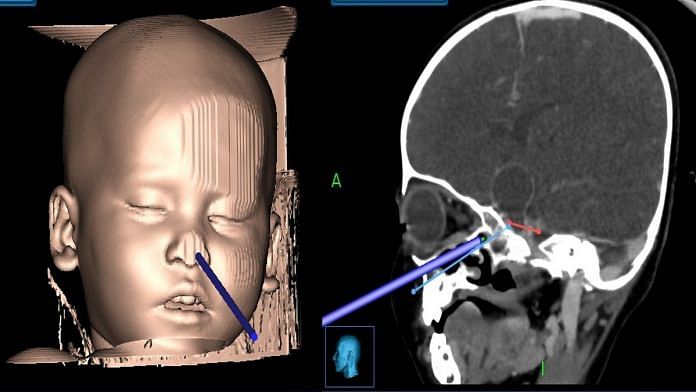New Delhi: Doctors at the Post Graduate Institute of Medical Education and Research (PGIMER), Chandigarh successfully removed a brain tumour through the nose of a 16-month-old girl.
The infant, who hails from Uttarakhand, was referred to PGIMER as she was unable to follow any visual stimuli, according to a press statement released Thursday. The child’s MRI had revealed that she had a 3 cm tumour, considered large for an infant, that was affecting her vision.
The hospital claimed she is the youngest patient in the world on whom such a surgery has been performed.
Dr Dhandapani S.S. of PGIMER’s Department of Neurosurgery, who was among the team of surgeons that performed the operation, told ThePrint that such a surgery is usually undertaken in children over six years.
“These kinds of tumours till 5-7 years would be operated on by opening the skull. Recently, we have started doing it through the nose at any good centres … The only problem is that we can only do this in those above six years and not those who are younger because the nose doesn’t have much space and the bone is very immature. The bone is hard because there is no space,” he said.
He added, “It was very scary to think about it in the first go, but somehow we had the conviction that we could do it.”
How tumour was removed
In 2019, doctors at Lucile Packard Children’s Hospital Stanford, US had performed such a surgery when they removed a two-year-old’s brain tumour.
“In less than two years, we broke the glass ceiling by doing it in a 1-year-4 month-old child,” said Dr Dhandapani. He said the surgery was meticulously planned. The doctors closely studied the MRI (Magnetic Resonance Imaging), CT scan and angiography, which were also used to create a computer-based 3-D navigation system.
The team, which also included Dr Sushant of the Neurosurgery Department and Dr Rijuneeta of ENT department, used miniaturised instruments to perform the surgery.
Unlike adults, infants do not have sinuses that are hollow cavities in the skull. “Air pockets provide a pathway to reach the tumour, when you don’t have that pathway you’ll have to create a cave, you’ll have to drill it,” Dr Dhandapani said.
The doctors used a diamond drill to create a pathway through which they were able to dissect the tumour. The surgery lasted around six hours.
“We went with an open mind because whether we are benefiting a patient or not, our first goal is not to harm the patient. So we didn’t want to take any undue risks also … But by God’s grace, everything went fine. The child was almost blind and has now regained vision with no complications so far. It has almost been almost 12 days and we are discharging her,” said Dhandapani.
Also read: Air pollution could be linked to higher prevalence of anaemia among children under 5 in India



